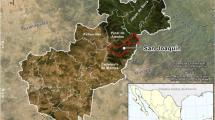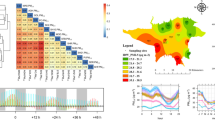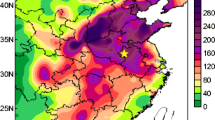Abstract
Coupling air pollutants with particular meteorological conditions can induce air pollution episodes. To our knowledge, how typhoons influence mercury (Hg) as an extreme weather phenomena has not been reported. Gaseous elemental Hg (GEM) was measured during a time period (from September 16, 2011 to October 9, 2011) that included three typhoons (Haitang, Nesat, and Nalgae) at the Wuzhishan National Atmospheric Background Station. The GEM concentration during these typhoons ranged from 1.81 to 4.73 ng/m3 (2.97 ± 0.58 ng/m3), 1.27 to 4.42 ng/m3 (2.69 ± 0.83 ng/m3), and 1.43 to 2.99 ng/m3 (2.47 ± 0.32 ng/m3), which was higher than for the non-typhoon period (1.14–2.93 ng/m3, 1.61 ± 0.52 ng/m3). Simultaneously, the three typhoon periods exhibited a significant positive correlation between the GEM concentration and wind speed. These results differ from the common belief that lower pollutant concentrations will occur due to a typhoon accelerating pollutant diffusion. Changes in the wind direction and long range pollutant transport from the Chinese mainland can reasonably account for this abnormality. There was a significantly positive correlation between the GEM and SO2, NO x , CO, and O3 levels during the three typhoons periods, which indicates they came from the same sources or areas. A backward trajectory analysis and the concentration weighted field at our monitoring site indicated that clean air masses mainly came from Southeast Asia or the southeast and northeast sea surfaces during non-typhoon periods, while polluted air masses came from the Chinese mainland during the three typhoon periods. The results implied that the increased GEM concentrations in the Wuzhi Mountain were caused by the long-range atmospheric transport of Hg from the Chinese mainland during the typhoon periods. The combustion of coal may be the main emission sources.





Similar content being viewed by others
References
Burke J, Hoyer M, Keeler G, Scherbatskoy T (1995) Wet deposition of mercury and ambient concentration at a site in the Lake Champlain basin water: mercury as a global pollutant. Springer, Netherlands, pp 353–362
Chang LT, Tsai JH, Lin JM, Huang YS, Chiang HL (2011) Particulate matter and gaseous pollutants during a tropical storm and air pollution episode in Southern Taiwan. Atmos Res 99:67–79
Chen LG, Liu M, Xu ZC, Fan RF, Tao J, Chen DH et al (2013) Variation trends and influencing factors of total gaseous mercury in the pearl river delta: a highly industrialised region in South China influenced by seasonal monsoons. Atmos Environ 77:757–766
Cheng WL, Lai LW, Den W, Wu MT, Hsueh CA, Lin PL et al (2014) The relationship between typhoons’ peripheral circulation and ground-level ozone concentrations in central Taiwan. Environ Monit Assess 186(2):791–804
Dastoor AP, Larocque Y (2004) Global circulation of atmospheric mercury: a modelling study. Atmos Environ 38:147–161
Ebinghaus R, Kock HH, Coggns AM, Spain TG, Jenning SG, Temme CH (2002) Long-term measurement of atmospheric mercury at Mace Head, Irish West Coast between 1995 and 2001. Atmos Environ 35(34):5267–5276
Fu XW, Feng XB, Zhu WZ, Wang SF, Lu JL (2008) Total gaseous mercury concentrations in ambient air in the eastern slope of Mt. Gongga, South-Eastern fringe of the Tibetan plateau, China. Atmos Environ 42(5):970–979
Fu XW, Feng XB, Zhang G, Xu WH, Li XD, Yao H et al (2010) Mercury in the marine boundary layer and seawater of the South China Sea: concentrations, sea/air flux, and implication for land outflow. J Geophys Res 115:D06303. doi:10.1029/2009JD012958
Fu XW, Feng XB, Zhang H, Yu B, Chen LG (2012) Mercury emission from natural surfaces highly impacted by human activities in Guangzhou Province, South China. Atmos Environ 54:182–193
Fu XW, Zhang H, Lin CJ, Feng XB, Zhou LX, Fang SX (2015) Correlation slopes of GEM/CO, GEM/CO2, and GEM/CH4 and estimated mercury emissions in China, South Asia, the Indochinese Peninsula, and Central Asia derived from observations in northwestern and southwestern China. Atmos Chem Phys 15:1013–1028
Gustin MS, Amos HM, Huang JY, Miller MB (2015) Successes and challenges of measuring and modeling atmospheric Hg at the part per quadrillion level: a critical review. Atmos Chem Phys Discuss 15:3777–3821
Hang TN, Kim HK, Kim MY, Shon ZH (2008) Exchange pattern of gaseous elemental mercury in an active urban landfill facility. Chemosphere 70:821–832
Holmes CD, Jacob DJ, Corbitt ES, Mao JQ, Yang X, Talbot RW (2010) Global atmospheric model for mercury including oxidation by bromine atoms. Atmos Chem Phys 10(24):12037–12057
Hsu YK, Holsen TM, Hopke PK (2003) Comparison of hybrid receptor models to locate PCB sources in Chicago. Atmos Environ 37:545–562
Huang JP, Fung JCH, Lau AKH, Qin Y (2005) Numerical simulation and process analysis of typhoon-related ozone episodes in Hong Kong. J Geophys Res 110(D5):D05301
Jaffe D, Prestbo E, Swartzendruber P, Penziasa PW, Kato S, Takami A, Hatakeyama S et al (2005) Export of atmospheric mercury from Asia. Atmos Environ 39:3029–3038
Kabashnikov VP, Chaikovsky AP, Kucsera TL, Metelskaya N (2011) Estimated accuracy of three common trajectory statistical methods. Atmos Environ 45:5425–5430
Kim KH, Ebinghaus R, Schroeder WH, Blanchard P, Kock HH, Steffen A (2005) Atmospheric mercury concentrations from several observatory sites in the northern hemisphere. J Atmos Chem 50:1–24
Lee DS, Dollard GJ, Pepler S (1998) Gas phase mercury in the atmospheric of the United Kingdom. Atmos Environ 32:855–864
Lei YT, Liu M, Chen LG, Xie DH, Lin DZ, Zhao MJ et al (2015) Variation characteristics of total gaseous mercury at Wuzhi Mountain background station in Hainan. Environ Sci 3:817–823 (in Chinese)
Lindberg S, Bullock R, Ebinghaus R, Engstrom D, Feng X, Fitzgerald W et al (2007) A synthesis of progress and uncertainties in attributing the sources of mercury in deposition. Ambio 36(1):19–32
Liu SL, Farhad N, Chris P, Carley RJ, Hoag GE, Lin Y et al (2002) Atmospheric mercury monitoring survey in Beijing, China. Chemosphere 48:97–107
Liu F, Cheng HX, Yang K, Zhao CD, Liu YH, Peng M et al (2014) Characteristics and influencing factors of mercury exchange flux between soil and air in Guangzhou City. J Geochem Explor 139:115–121
Miller EK, Vanarsdale A, Keeler GJ, Chalmers A, Poissant L, Kamman NC et al (2005) Estimation and mapping of wet and dry mercury deposition across northeastern North America. Ecotoxicology 14:53–70
Pacyna EG, Pacyna JM, Steenhuisenc F, Wilson S (2006) Global anthropogenic mercury emission inventory for 2000. Atmos Environ 40:4048–4063
Parrella JP, Jacob DJ, Liang Q, Zhang Y, Mickley LJ, Miller B et al (2012) Tropospheric bromine chemistry: implications for present and pre-industrial ozone and mercury. Atmos Chem Phys 12(15):6723–6740
Pirrone N, Costa P, Pacyna JM, Ferrara R (2001) Mercury emissions to the atmosphere from natural and anthropogenic sources in the Mediterranean region. Atmos Environ 35:2997–3006
Pirrone N, Cinnirella S, Feng X, Finkwlman RB, Friedli HR, Leaner J et al (2010) Global mercury emissions to the atmosphere from anthropogenic and natural sources. Atmos Chem Phys 10:5951–5964
Sander R, Keene WC, Pszenny AAP, Arimoto R, Ayers GP, Baboukas E et al (2003) Inorganic bromine in the marine boundary layer: a critical review. Atmos Chem Phys 3(5):1301–1336
Schroeder WH, Munthe J (1998) Atmospheric mercury: an overview. Atmos Environ 32(5):809–822
Seigneur C, Karamchandani P, Lohman K, Vijayaraghacan K, Shia RL (2001) Multiscale modeling of the atmospheric fate and transport of mercury. J Geophys Res 106:27795–27809
Shi Y, Xia YF, Lu BH, Liu N, Zhang L, Li SJ et al (2014) Emission inventory and trends of NOx for China, 2000–2020. J Zhejiang Univ Sc A 15(6):454–464
Slemr F, Scheel HE (1998) Trends in atmospheric mercury concentration at the summit of the Wank mountain, southern Germany. Atmos Environ 32:845–853
Slemr F, Brunke E, Ebinghaus R, Temme C, Munthe J, Wängberg I et al (2003) Worldwide trend of atmospheric mercury since 1977. Geophys Res Lett 30(10):1516
Valente RJ, Shea C, Humes K, Tanner RL (2007) Atmospheric mercury in the Great Smoky mountains compared to regional and global levels. Atmos Environ 41(9):1861–1873
Wan Q, Feng XB, Lu J, Zheng W, Song XJ, Han SJ et al (2009) Atmospheric mercury in Changbai Mountain area, northeastern China: the seasonal distribution pattern of total gaseous mercury and its potential sources. Environ Res 109:201–206
Wang LT, Zhang Q, Hao JM, He KB (2005) Anthropogenic CO emission inventory of Mainland China. Acta Sci Circum 25(12):1580–1585
Wang YQ, Zhang XY, Draxler R (2009) TrajStat: GIS-based software that uses various trajectory statistical analysis methods to identify potential sources from long-term air pollution measurement data. Environ Modell Softw 24(8):938–939
Wang ZC, Zhi SQ, Ding LY (2013) Observation and analysis on Qiongzhou strait gales of severe typhoon Nesat (2011). J Appl Meteorol Sci 24(5):595–605 (in Chinese)
Wu M, Fan SJ, Wu D (2013) The characteristics of atmospheric boundary layer during tropical cyclone process and its influence on air quality over Pearl River Delta region. China Environ Sci 33(9):1569–1576 (in Chinese)
Xia CH, Xie ZQ, Sun LG (2010) Atmospheric mercury in the marine boundary layer along a cruise path from Shanghai, China to Prydz Bay, Antarctica. Atmos Environ 44:1815–1821
Zhang L, Wang SX, Wang L, Wu Y, Duan L, Wu QR et al (2015) Updated emission inventories for speciated atmospheric mercury from anthropogenic sources in China. Environ Sci Technol 49:3185–3194
Acknowledgments
This study was funded by the Commonwealth and Environmental Protection Project of the Ministry of Environmental Protection of the People’s Republic of China (MEP) (No. 200809011), the National Natural Science Foundation of China (Nos. 41273107, 41105082 and 51308132) and Special Scientific Research Funds for Environmental Protection Commonweal Section (PM-zx021-201311-038).
Author information
Authors and Affiliations
Corresponding authors
Rights and permissions
About this article
Cite this article
Gao, Z., Sun, J., Liu, M. et al. Variational Characteristics and Implications of Gaseous Elemental Mercury for Three Continuous Typhoons in China. Arch Environ Contam Toxicol 70, 692–699 (2016). https://doi.org/10.1007/s00244-015-0225-9
Received:
Accepted:
Published:
Issue Date:
DOI: https://doi.org/10.1007/s00244-015-0225-9




